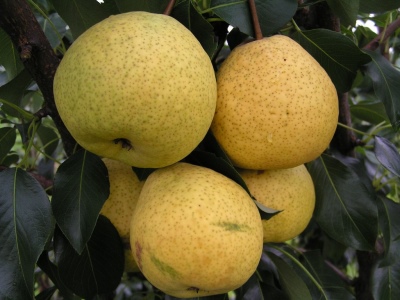
- Fruit weight, g: up to 130
- Ripening terms: summer
- Fruit picking time: In the end of August
- Appointment: dining room, preparation of compotes, preparation of dried fruits
- Growth type: tall
- Yield: high
- Transportability: medium
- Height, m: from 4
- Crown: wide, pyramidal, spreading
- Fruiting type: on ringlets
Pear trees are as popular and loved by gardeners as apple trees. Pears are happily planted in gardens and in adjoining territories in various regions of the country. Many varieties were bred in the 19th century, they are still cultivated today. An interesting old pear variety is Great Summer, its other name is Big Summer.
Breeding history
The selection of pear crops has been of interest to many famous breeders since Soviet times. So, much in this direction was done by the staff of the Mliev Institute of Pomology. L. P. Simirenko (Ukraine, Cherkassy). Here experts and enthusiasts have collected the world's largest collection of pear varieties in the amount of 575 copies with a detailed description. It was on the basis of this scientific center in 1934 that a new pear variety called Big Summer was obtained. The well-known Russian cultivar Ilyinka and the American early-ripening variety Lyubimitsa Klappa were taken as parents.
Description of the variety
The tree is vigorous, it can reach a height of 4 m and more. The crown is wide-pyramidal, spreading, drooping. The pear grows quickly, is fast-growing, after planting it begins to bear fruit already for 3-4 years. Self-fertile.
Fruit characteristics
Fruits are broad, pear-shaped, symmetrical. Pears start at 130g but can grow up to 200g if cared for properly. The fruits are greenish-yellow in color, there is a slight pinkish blush, without shine. Not prone to shedding.
Taste qualities
The pulp of the pear is white, juicy, oily, without hardened areas near the seed chamber. Fruits are stored for up to 2 weeks.
The fruit taste is sweet, there is a slight sourness. The pear has mainly a table purpose, and is also suitable for boiling compote, producing dried fruits.
Ripening and fruiting
The Big Summer variety, as the name suggests, represents a group of summer varieties. The first fruits ripen in the last days of August, the tree also bears fruit in September.

Yield
The pear variety in question has a high yield.
Growing regions
Big summer pear is zoned for Moscow, as well as for the Moscow region. As for the Non-Black Earth Region, here it has an average winter hardiness. Experts recommend it for cultivation in the North Caucasus and the Black Earth Region, where it can bring good yields. And also the variety is widespread in Ukraine, here it bears fruit well, it is better known as Velikaya.
Landing
Planting pears has its own characteristics. Saplings should be chosen 1–2 years old, without foliage, with a well-developed root system.
It is better to plant the crop in the fall (end of September) on the sunny side of the site, in a place protected from the wind. The soil is preferable loamy, sandy loam, podzolic-soddy. Necessarily fertile, drained, neutral acidity.
A seedling is placed in a pit (100X100X80 cm), a peg is immediately strengthened next to which a young tree will be tied. The roots are covered with soil, while it is necessary to leave the root collar on the surface, approximately at a distance of 6–8 cm from the ground. Then the ground is trampled down, the seedling is well watered, then mulch is poured.


Growing and care
The Great Pear variety requires systematic and uncomplicated care, which differs depending on the season. So, in the spring it is necessary to whitewash the trunk, feed it with fertilizers with nitrogen in the composition, form the crown by cutting. And also spring activities include spraying with a Bordeaux mixture (before the buds bloom), preventive treatment against pests, the introduction of potash fertilizers before flowering and watering in its process.
In the summertime, it is necessary to remove weeds in the near-trunk circle, water the tree abundantly while setting the fruit. Autumn activities begin with feeding the tree with compounds with phosphorus, then it is necessary to spray the crown with urea, mulch the soil with humus around the trunk, and also whitewash it in late autumn.
Preparation for winter is also required. It is necessary to cut off all damaged, improperly growing branches, protect the trunk from low temperatures, as well as rodents.



Disease and pest resistance
The variety is resistant not only to scab, but also to other ailments of a fungal nature.

Like any other fruit trees, the pear needs protection from various diseases and pests. When planting a pear on your site, you need to know in advance what diseases you should beware of. To successfully carry out the struggle, it is necessary first to correctly identify the cause of the problem. It is important to distinguish signs of disease from manifestations of the presence of insects, mites, caterpillars and other types of pests.
Resistance to soil and climatic conditions
The described culture is drought-resistant, while its winter hardiness is low.





































































